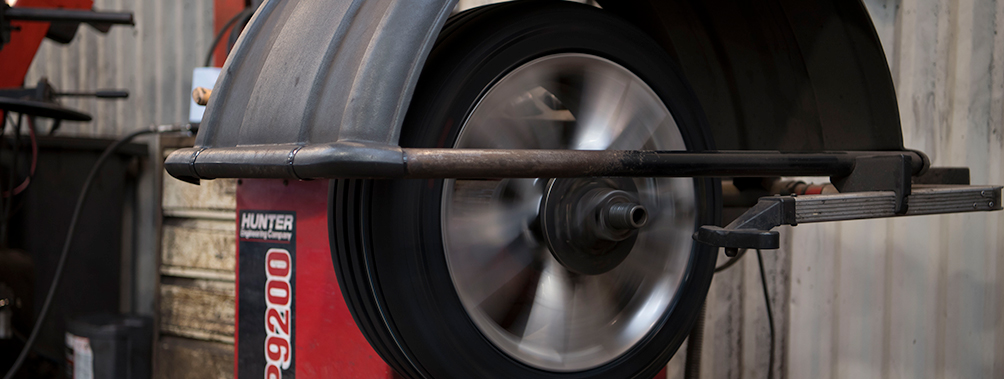
TYRE PRESSURE
Having the correct pressure in your tyres ensures a longer life expectancy of the tyres and better fuel efficiency not to mention a better grip of the road surface ensuring better safety.
Ideally, you should familiarise yourself with the correct pressure for your vehicle by reading the user manual and check the pressures regularly, say once a month, and before any long journeys. This also includes the spare tyre.
It is best to check the pressures when the tyres are cold, however, if this is not possible, add approximately 5 psi to the recommended pressures.
If you are unsure or not confident in checking the pressures, please feel free to call into us for a free check by one of our experienced tyre technicians.
Not only can low pressure lead to the overheating of the tyre, possibly causing it to burst, but the lack of pressure can result in the vehicle understeering (front tyres) or oversteering (rear tyres) causing a safety hazard.
If your tyres are suffering from a significantly quick or regular loss of pressure it is advisable to have the condition of the tyres checked.
NITROGEN INFLATION
The correct pressure of your tyre can be maintained for longer by opting for nitrogen inflation as the rate at which nitrogen passes out of the walls of tyres is much slower than that of air.
Low pressure results in wear and tear of your tyre as it creates resistance to movement which could result in your tyres wearing out quickly. The correct pressure optimises fuel efficiency and reduces emissions.
At A&A Tyres (Aberdare) we offer both nitrogen inflation and air inflation.
TYRE LABELLING
Tyres for most cars, 4x4, vans and trucks have to show a standard label, according to EU regulations, to give motorists a comparable and reliable visual indication of performance of the tyre. The scale ranges from A (the best) to G (the worst). With regard to the fuel efficiency and wet grip classification D is not used in order to give a very clear indication between the best and worst performers. The scales shown on each label relate to:
Fuel Efficiency
Tyres that have a lower rolling resistance use less energy and thus use less fuel and, therefore, CO2 emissions are reduced. A tyre with an A ranking can reduce fuel consumption by up to 7.5% over tyres ranked G.
Wet Grip Performance
Tyres with a high wet grip ranking have a shorter braking distance in wet conditions. Each ranking is separated by approximately one car’s length in braking distance which means a tyre ranked A could reduce braking distance by approximately 18 metres over a tyre ranked G.
Noise Classification
In order to reduce noise pollution, the external rolling noise ranking is designed to encourage motorist to choose a low noise tyre. The lower the dB ranking the quieter the tyre.
PREMIUM OR ECONOMY TYRES?
A vehicle is usually the second largest purchase you will make in your lifetime, after your home. Why choose the cheapest tyre to go on one of the most expensive purchases you will ever make? Would you compromise safety in your home by installing the cheapest boiler? So why compromise safety by fitting the cheapest tyre.
The tyres on your vehicle keep you on the road and are the only thing between your car and the road and the consideration of safety should be paramount.
A premium tyre in comparison to an economy tyre provides improved performance, advanced technology and greater safety. An economy tyre can result in decreased fuel efficiency as well as a reduced life expectancy and, therefore, can make the purchase a false economy.
Premium tyre manufacturers use the most up-to-date technology and quality materials whilst working extremely closely with car manufacturers. The tyres are manufactured for the ultimate safety, life expectancy, fuel efficiency and grip. Some economy tyres are manufactured with very dated technology and lower quality materials resulting in a poorer all round performance.
TREAD PATTERNS
Symmetrical Tread
Symmetrical tread is the most common pattern and both halves of the tread pattern (either side of the centre of the tread) are identical. Therefore, there is no 'right' or 'wrong' way round to fit the tyre. This tread ensures good road holding and is very quiet. It provides low rolling resistance which, in turn, increases the lifetiime of the tyre and provides good fuel efficiency.
Asymmetrical Tread
An asymmetrical tread has a different pattern on either side of the centre of the tread. It is essential that these tyres are fitted in a particular position and, therefore, they have 'inside' and 'outside' markings to avoid incorrect fitting. An asymmetrical tread provides both excellent dry and wet performance. The inner tread provides protection against aquaplaning by water displacement and the outer tread gives a high level of road grip when cornering and on dry roads. This tread is especially popular for high performance cars.
Directional Tread
Directional tread has an arrow shaped pattern designed to roll in one particular direction. Therefore, particular care must be taken in fitting the tyre in the correct position and, to ensure the correct fitting, the tyre is marked with an arrow. Directional tread gives high protection against aquaplaning and provides good directional stability, however, in dry conditions, the tread design excels in discouraging heat build up of the tyre and providing high performance.
